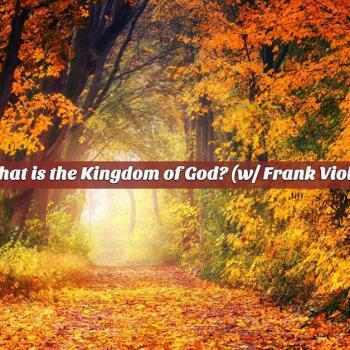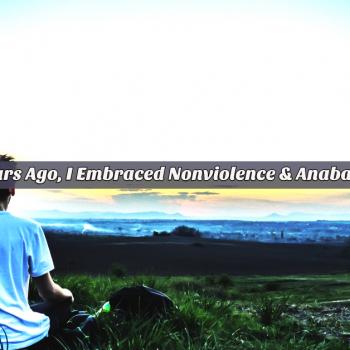Yesterday I posted my “Dear Reader… Deconstructing Religion– Moving Beyond in and out” and have had multiple responses. Mostly positive, but one that was a bit skeptical made me realize that I ought to give you a bit more context on the concept of Centered vs Bounded sets in ethics. My exploration of this was inspired by Mark Baker’s, Religious No More: Building Communities of Grace and Freedom.
First off, I want to remind all of us that any image or analogy breaks down somewhere. There was some push back about the negatives of the second image missing some things. The one that sticks out most was from Ken Bussell over at “Emerging Worshipper.” He said: “…a problem I see with these illustrations is that they fail to describe the movement of God. God is moving toward us and pursuing us as well, is He not? In a sense we are all a part of the in-group, in that God is pursuing all of us.” To this I simply say that it would have been appropriate to have arrows from God pointing to all the other arrows, no matter their direction.
I also had a more detailed discussion on Facebook regarding this with my good friend James-Michael Smith who blogs at Discipleship Dojo. He is an excellent blogger who I commend to you, even though we may have a hint of disagreement on this issue. This what I want to direct your attention to for the remainder of this post…
Kurt, I came across these models in the book “Who Is My Enemy? – Welcoming people the church rejects” by Rich Nathan, and while I think there are some good points made and questions raised, I don’t think any of the sets completely encompass… the NT’s overall teaching.
For instance, there are clear uses of the “bounded set” approach at times in Paul’s letters, specifically to the Corinthians where he talks about not judging those “outside” the church, but rather “within” it. Also in the language of casting “out” the immoral brother so that he is “handed over to satan”, etc.
Likewise, Jesus many times spoke of the fate of “those outside” the Kingdom or told people they “were not far from” the Kingdom.
Revelation and 1John, more than any other books in the NT, both employ language of those “in” Christ and those “in/of the world”/”Babylon.”
In the end, I think that any systematizing or diagramming of the Kingdom will fall flat in some areas; I believe that’s the case even with more Emergent forms of “Centered Group” approaches. I think it’s overly simplistic and appeals more to our emotional desire to not be judgmental and a reactionary stance against Fundamentalism’s exclusivistic tendencies than to exegetical arguments from the NT itself.
MY RESPONSE: J-M and Ian (another FB friend who affirmed J-M)… I have to disagree with you in some senses and think we may be talking past each other some as well. Also, I’d say that any image or analogy breaks down at some point, but we ought to try! So, here is a response…
First of all. being part of the covenant community means that we have been incorporated into “Christ’s action” not our own. Christ did the work so that we do not have to live with a performance-based ethic. This is thematic throughout the book of Galatians. Baker’s book is an exegetical/theological work reflecting on religiosity vs the freedom that believers have in Christ. He expounds Galatians… this book is a mini-commentary in many ways. It is a modified version of his PhD dissertation and is endorsed by Richard B. Hays (whom he sat under at Duke) and Joel B Green who are by no means “Emergent” as you say. Leading up to his discussion of bounded and centered sets, he has been reflecting on Galatians 3:28 and its broader context. He states:
“…the gospel Paul preached produces a community that brings individuals in, not because of what the individual has done, but because of Christ’s faithfulness, which has led to the destruction of the barriers of separation…. Paul’s emphasis on Christ’s faithfulness means that to believe is to recognize that one is ‘in.’ Belief is no the step that earns entrance; the Christian is in because of what Christ has done. Belief is trusting that Christ has erased the boundaries. To believe Christ is to live in that truth. If Paul had said, ‘It is not circumcision but faith in Christ that marks entry into the covenant,’ he would have been offering a new religious system, a new way to set up barriers of separation. Instead, Paul argues that Christ has destroyed religion and its boundary lines. (*NOTE: He argues for pistis being translated “faithfulness” of Christ, not “faith” in Christ)(121)
So, his discussion that follows on page 123 has this section of Galatians in the background. His concern, as is mine, is that when we add requirements as prerequisite to following Christ rather than seeing is redemptive work as demolishing all religion, we contradict what Paul was wrestling with in Galatia. That does not mean that “all goes” as I make clear in my post. But rather that when our ethic is on the center (God in Christ), then the closer we are to the center (sanctification to use old language), then the more our behaviors will come into the character of such a center.
Secondly, Mark says that often the Christian church expresses itself as a “Bounded set” or as he says, they draw borders for who is in and who is out of the covenant community. He suggests that we ought to be more like a ‘tent’ than a wall or borderline. Mark goes on to say:
“…both a religious community and a ‘new creation’ community will have boundary markers that help define who is part of the community, but the character of these boundaries is decidedly different. Returning to our building image, we observe a thick wall that surrounds the religious building and serves as a boundary of separation. In contrast, no barrier surrounds the ‘new-creation’ tent—the tent itself does not even have sides. Even so, one can still differentiate between those inside the tent and those outside. Both communities have means of defining who is ‘in,’ but the means are so different they have very little in common…. A Christian, in response to God’s action of inclusion and adoption, will act decidedly differently from those outside the tent. It is not, however, the actions that keep the Christian inside the tent; it is the relationship with the Spirit of Christ and other Christians. Actions of a certain character flow from that relationship and help identify someone as a new-creation tent dweller.” (122)
The following page, 123, is where bounded vs centered sets are formally discussed.
Well, I hope that this gives a bit more for J-M and Ian to chew on. Ian, to briefly state, baptism is a mark of a relationship that is already being formed, not a requirement for inclusion into the community of God. Sorry for the long quotes, but I thought I’d let Mark speak for himself 🙂
ANY THOUGHTS?
PS – See J-M Smith’s reply on the first comment. Good stuff. Like I said, he is a stud blogger!












